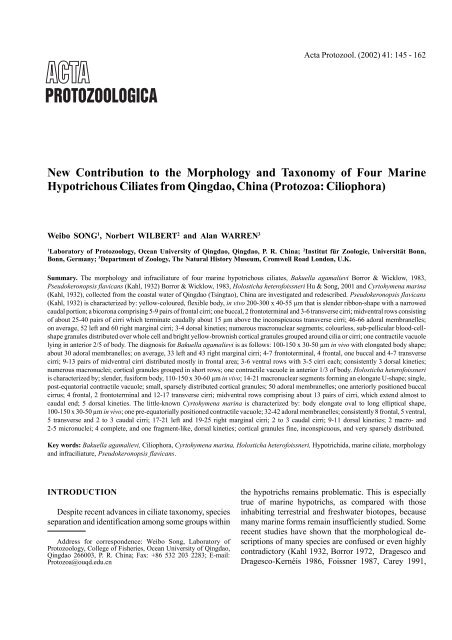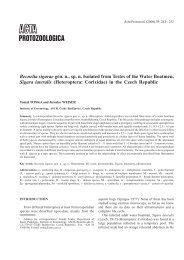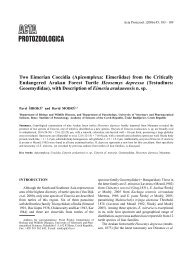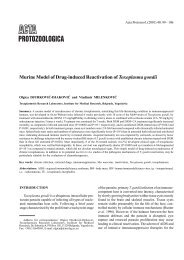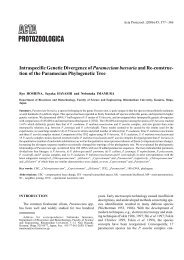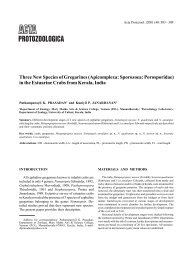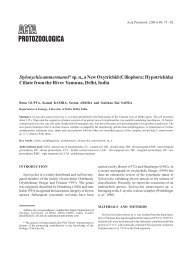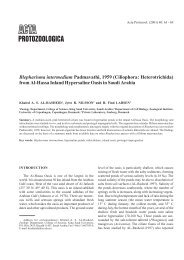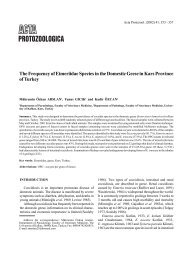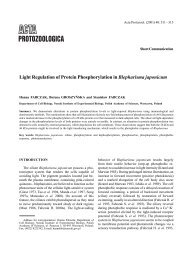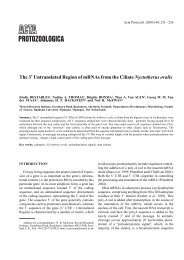New Contribution to the Morphology and Taxonomy of Four Marine ...
New Contribution to the Morphology and Taxonomy of Four Marine ...
New Contribution to the Morphology and Taxonomy of Four Marine ...
You also want an ePaper? Increase the reach of your titles
YUMPU automatically turns print PDFs into web optimized ePapers that Google loves.
Acta Pro<strong>to</strong>zool. (2002) 41: 145 - 162<br />
<strong>New</strong> <strong>Contribution</strong> <strong>to</strong> <strong>the</strong> <strong>Morphology</strong> <strong>and</strong> <strong>Taxonomy</strong> <strong>of</strong> <strong>Four</strong> <strong>Marine</strong><br />
Hypotrichous Ciliates from Qingdao, China (Pro<strong>to</strong>zoa: Ciliophora)<br />
Weibo SONG 1 , Norbert WILBERT 2 <strong>and</strong> Alan WARREN 3<br />
1<br />
Labora<strong>to</strong>ry <strong>of</strong> Pro<strong>to</strong>zoology, Ocean University <strong>of</strong> Qingdao, Qingdao, P. R. China; 2 Institut für Zoologie, Universität Bonn,<br />
Bonn, Germany; 3 Department <strong>of</strong> Zoology, The Natural His<strong>to</strong>ry Museum, Cromwell Road London, U.K.<br />
Summary. The morphology <strong>and</strong> infraciliature <strong>of</strong> four marine hypotrichous ciliates, Bakuella agamalievi Borror & Wicklow, 1983,<br />
Pseudokeronopsis flavicans (Kahl, 1932) Borror & Wicklow, 1983, Holosticha heter<strong>of</strong>oissneri Hu & Song, 2001 <strong>and</strong> Cyr<strong>to</strong>hymena marina<br />
(Kahl, 1932), collected from <strong>the</strong> coastal water <strong>of</strong> Qingdao (Tsingtao), China are investigated <strong>and</strong> redescribed. Pseudokeronopsis flavicans<br />
(Kahl, 1932) is characterized by: yellow-coloured, flexible body, in vivo 200-300 x 40-55 µm that is slender ribbon-shape with a narrowed<br />
caudal portion; a bicorona comprising 5-9 pairs <strong>of</strong> frontal cirri; one buccal, 2 fron<strong>to</strong>terminal <strong>and</strong> 3-6 transverse cirri; midventral rows consisting<br />
<strong>of</strong> about 25-40 pairs <strong>of</strong> cirri which terminate caudally about 15 µm above <strong>the</strong> inconspicuous transverse cirri; 46-66 adoral membranelles;<br />
on average, 52 left <strong>and</strong> 60 right marginal cirri; 3-4 dorsal kineties; numerous macronuclear segments; colourless, sub-pellicular blood-cellshape<br />
granules distributed over whole cell <strong>and</strong> bright yellow-brownish cortical granules grouped around cilia or cirri; one contractile vacuole<br />
lying in anterior 2/5 <strong>of</strong> body. The diagnosis for Bakuella agamalievi is as follows: 100-150 x 30-50 µm in vivo with elongated body shape;<br />
about 30 adoral membranelles; on average, 33 left <strong>and</strong> 43 right marginal cirri; 4-7 fron<strong>to</strong>terminal, 4 frontal, one buccal <strong>and</strong> 4-7 transverse<br />
cirri; 9-13 pairs <strong>of</strong> midventral cirri distributed mostly in frontal area; 3-6 ventral rows with 3-5 cirri each; consistently 3 dorsal kineties;<br />
numerous macronuclei; cortical granules grouped in short rows; one contractile vacuole in anterior 1/3 <strong>of</strong> body. Holosticha heter<strong>of</strong>oissneri<br />
is characterized by; slender, fusiform body, 110-150 x 30-60 µm in vivo; 14-21 macronuclear segments forming an elongate U-shape; single,<br />
post-equa<strong>to</strong>rial contractile vacuole; small, sparsely distributed cortical granules; 50 adoral membranelles; one anteriorly positioned buccal<br />
cirrus; 4 frontal, 2 fron<strong>to</strong>terminal <strong>and</strong> 12-17 transverse cirri; midventral rows comprising about 13 pairs <strong>of</strong> cirri, which extend almost <strong>to</strong><br />
caudal end; 5 dorsal kineties. The little-known Cyr<strong>to</strong>hymena marina is characterized by: body elongate oval <strong>to</strong> long elliptical shape,<br />
100-150 x 30-50 µm in vivo; one pre-equa<strong>to</strong>rially positioned contractile vacuole; 32-42 adoral membranelles; consistently 8 frontal, 5 ventral,<br />
5 transverse <strong>and</strong> 2 <strong>to</strong> 3 caudal cirri; 17-21 left <strong>and</strong> 19-25 right marginal cirri; 2 <strong>to</strong> 3 caudal cirri; 9-11 dorsal kineties; 2 macro- <strong>and</strong><br />
2-5 micronuclei; 4 complete, <strong>and</strong> one fragment-like, dorsal kineties; cortical granules fine, inconspicuous, <strong>and</strong> very sparsely distributed.<br />
Key words: Bakuella agamalievi, Ciliophora, Cyr<strong>to</strong>hymena marina, Holosticha heter<strong>of</strong>oissneri, Hypotrichida, marine ciliate, morphology<br />
<strong>and</strong> infraciliature, Pseudokeronopsis flavicans.<br />
INTRODUCTION<br />
Despite recent advances in ciliate taxonomy, species<br />
separation <strong>and</strong> identification among some groups within<br />
Address for correspondence: Weibo Song, Labora<strong>to</strong>ry <strong>of</strong><br />
Pro<strong>to</strong>zoology, College <strong>of</strong> Fisheries, Ocean University <strong>of</strong> Qingdao,<br />
Qingdao 266003, P. R. China; Fax: +86 532 203 2283; E-mail:<br />
Pro<strong>to</strong>zoa@ouqd.edu.cn<br />
<strong>the</strong> hypotrichs remains problematic. This is especially<br />
true <strong>of</strong> marine hypotrichs, as compared with those<br />
inhabiting terrestrial <strong>and</strong> freshwater bio<strong>to</strong>pes, because<br />
many marine forms remain insufficiently studied. Some<br />
recent studies have shown that <strong>the</strong> morphological descriptions<br />
<strong>of</strong> many species are confused or even highly<br />
contradic<strong>to</strong>ry (Kahl 1932, Borror 1972, Dragesco <strong>and</strong><br />
Dragesco-Kernéis 1986, Foissner 1987, Carey 1991,
146 W. Song et al.<br />
Petz et al. 1995, Wilbert 1995, Song <strong>and</strong> Packr<strong>of</strong>f 1997,<br />
Berger 1999, Song <strong>and</strong> Hu 1999).<br />
The current work forms part <strong>of</strong> a faunistic study <strong>of</strong><br />
ciliates in <strong>the</strong> coastal waters <strong>of</strong> <strong>the</strong> north China seas,<br />
which has been carried out for a period <strong>of</strong> over 10 years.<br />
In this paper, 4 previously known but poorly described<br />
species <strong>of</strong> hypotrichs, collected from <strong>of</strong>fshore mariculture<br />
waters near Qingdao, China, are redescribed following<br />
examination using modern techniques.<br />
MATERIALS AND METHODS<br />
Sample sites. All samples were collected from mariculture waters<br />
near <strong>the</strong> coast <strong>of</strong> Qingdao (Tsingtao, 36 o 08’N; 120 o 43’E), China.<br />
Bakuella agamalievi <strong>and</strong> Cyr<strong>to</strong>hymena marina were isolated (6 May<br />
1997) from a semi-closed pond used for mollusc culture (salinity<br />
10-15 ‰). Pseudokeronopsis flavicans was isolated on two occasions<br />
(6 <strong>and</strong> 12 May 1997) from <strong>the</strong> same sampling site as above.<br />
Two populations <strong>of</strong> Holosticha heter<strong>of</strong>oissneri were collected on<br />
separate occasions (31 March 1995 <strong>and</strong> 28 Oc<strong>to</strong>ber 1997) from an<br />
open scallop (Chlamys farreri) farming pond (salinity 31-32 ‰).<br />
General methods. After collection <strong>and</strong> isolation, specimens were<br />
maintained in <strong>the</strong> labora<strong>to</strong>ry for several weeks, ei<strong>the</strong>r as pure or raw<br />
cultures in Petri dishes, with rice grains as food source for bacteria.<br />
Observations on living morphology were undertaken using Nomarski<br />
optics. Protargol staining (Wilbert 1975) was performed for revealing<br />
<strong>the</strong> infraciliature <strong>and</strong> nuclear apparatus. Counts <strong>and</strong> measurements<br />
were made at a magnification <strong>of</strong> x1250. Drawings were made with <strong>the</strong><br />
help <strong>of</strong> a camera Lucida. Terminology is mainly according <strong>to</strong> Foissner<br />
(1982) <strong>and</strong> Hemberger (1985).<br />
<strong>New</strong> type specimens. Since no type specimens <strong>of</strong> Bakuella<br />
agamalievi, Cyr<strong>to</strong>hymena marina or Pseudokeronopsis flavicans are<br />
known <strong>to</strong> exist, one neotype slide <strong>of</strong> protargol impregnated cells <strong>of</strong><br />
each species has been deposited in <strong>the</strong> collection <strong>of</strong> <strong>the</strong> Natural<br />
His<strong>to</strong>ry Museum, London, UK with <strong>the</strong> following registration numbers:<br />
Bakuella agamalievi, 2001:1z:z8:01; Cyr<strong>to</strong>hymena<br />
marina, 2001:1z:z8:02; Pseudokeronopsis flavicans, 2001:1z:z8:03.<br />
In addition one paraneotype <strong>of</strong> each has been deposited in <strong>the</strong><br />
Labora<strong>to</strong>ry <strong>of</strong> Pro<strong>to</strong>zoology, Ocean University <strong>of</strong> Qingdao, People’s<br />
Republic China.<br />
RESULTS<br />
Bakuella agamalievi Borror & Wicklow, 1983<br />
(Figs 1-8, 52-53; Table 1)<br />
Syn. Holosticha manca sensu Agamaliev, 1972<br />
Borror <strong>and</strong> Wicklow (1983) reclassified this species<br />
but did not give a clear definition; hence we supply here<br />
<strong>the</strong> species diagnosis based on <strong>the</strong> present studies.<br />
Improved diagnosis. <strong>Marine</strong> Bakuella with elongated<br />
body shape, 100-150 x 30-50 µm in vivo; about<br />
30 adoral membranelles; on average, 33 left <strong>and</strong> 43 right<br />
marginal cirri; 4-7 fron<strong>to</strong>terminal, 4 frontal, one buccal<br />
<strong>and</strong> 4-7 transverse cirri; 9-13 pairs <strong>of</strong> midventral cirri<br />
distributed mostly in frontal area; 3-6 ventral rows with<br />
3-5 cirri each; consistently 3 dorsal kineties; numerous<br />
macronuclei; cortical granules grouped in short rows;<br />
one contractile vacuole in anterior 1/3 <strong>of</strong> cell.<br />
Morphological description. Body shape generally<br />
constant, length <strong>to</strong> width ratio about 3:1 with both ends<br />
well rounded; cell margins almost parallel with slight<br />
bulge in middle portion (Fig. 1). Buccal field about 1/3 <strong>to</strong><br />
2/5 body length (Fig. 1). Pellicle rigid, cortical granules<br />
colorless or slightly greenish when observed at low<br />
magnification, about 0.8 µm across, typically grouped<br />
<strong>to</strong>ge<strong>the</strong>r <strong>and</strong> sparsely arranged in short rows on both<br />
ventral <strong>and</strong> dorsal sides <strong>of</strong> cell (Figs 2, 3, 53). Cy<strong>to</strong>plasm<br />
colourless <strong>to</strong> grayish, usually containing numerous shiny<br />
globules (2-5 µm in diameter), which render <strong>the</strong> cell<br />
completely opaque. Food vacuoles large, usually several<br />
in number, <strong>and</strong> containing flagellate, small ciliates or<br />
bacteria. Contractile vacuole (CV) situated near left<br />
border about 1/3 <strong>to</strong> 2/5 <strong>of</strong> <strong>the</strong> way down <strong>the</strong> body (Figs<br />
1, 3). Pulsation interval ra<strong>the</strong>r long (up <strong>to</strong> 5 min). About<br />
50 ellipsoid macronuclear nodules, each ca 3-5 µm long<br />
<strong>and</strong> containing several large nucleoli; micronuclei globular,<br />
only recognized after protargol staining (Fig. 8).<br />
Locomotion moderately fast, crawling on substrate,<br />
sometimes jerking back <strong>and</strong> forth.<br />
Adoral zone <strong>of</strong> membranelles about 1/3 <strong>of</strong> cell length<br />
with distal end only slightly curved <strong>to</strong>wards right border.<br />
Bases <strong>of</strong> membranelles ca 7-8 µm in length. Cilia <strong>of</strong><br />
membranelles 15-20 µm long. Undulating membranes<br />
relatively long, slightly curved <strong>and</strong> noticeably crossed<br />
(Figs 4, 7).<br />
Somatic ciliature typical <strong>of</strong> genus. Three slightly<br />
enlarged, <strong>and</strong> one smaller, frontal cirrus arranged in<br />
anteriormost portion <strong>of</strong> frontal area; cirri about 20 µm<br />
long. One buccal cirrus near anterior 1/3 <strong>of</strong> undulating<br />
membranes (Fig. 4). Mostly 6 fron<strong>to</strong>terminal cirri relatively<br />
fine, located at anterior terminus <strong>of</strong> right marginal<br />
row (Figs 4, 7). Midventral rows composed <strong>of</strong> closely<br />
spaced oblique pairs <strong>of</strong> cirri <strong>and</strong> extending <strong>to</strong> about <strong>the</strong><br />
level <strong>of</strong> <strong>the</strong> cy<strong>to</strong>s<strong>to</strong>me (Fig. 7). Posterior <strong>to</strong> <strong>the</strong>se<br />
midventral rows are (usually) 4-5 ventral rows (arrows<br />
in Fig. 7) each with 3 <strong>to</strong> 5 cirri, which are also obliquely
On four marine hypotrichs 147<br />
Figs 1-8. Bakuella agamalievi from life (1-3, 6), after silver nitrate (5) <strong>and</strong> protargol impregnation (4, 7, 8). 1 - ventral view <strong>of</strong> a typical<br />
specimen; 2 - optical section <strong>of</strong> cortex, <strong>to</strong> show <strong>the</strong> cortical granules; 3 - dorsal view from life; note <strong>the</strong> arrangement <strong>of</strong> <strong>the</strong> cortical granules;<br />
4 - anterior portion <strong>of</strong> infraciliature, <strong>to</strong> show <strong>the</strong> buccal apparatus <strong>and</strong> <strong>the</strong> ciliature on ventral side; 5 - ventral side (redrawn from Agamaliev,<br />
1972, called Holosticha manca); 6 - lateral view from life; 7, 8 - ventral <strong>and</strong> dorsal views <strong>of</strong> infraciliature; arrows in Fig. 7 mark <strong>the</strong> short ventral<br />
rows. AZM - adoral zone <strong>of</strong> membranelles, BC - buccal cirrus, Cph - cy<strong>to</strong>pharynx, CV - contractile vacuole, DK3 - dorsal kinety No. 3,<br />
EM - endoral membrane, FC - frontal cirri, FTC - fron<strong>to</strong>terminal cirri, Ma - macronuclei, Mi - micronuclei, MVR - midventral rows,<br />
PM - paroral membrane, RMR - right marginal row, TC - transverse cirri, VR - ventral rows. Scale bars - 50 µm
148 W. Song et al.<br />
Table 1. Morphometrical data <strong>of</strong> Bakuella agamalievi Borror & Wicklow, 1983 (upper line) <strong>and</strong> Holosticha heter<strong>of</strong>oissneri (lower line).<br />
All data are based on protargol impregnated specimens. Measurements in µm. Abbreviation: CV - coefficient <strong>of</strong> variation in %;<br />
Max - maximum, Min - minimum, n - number <strong>of</strong> cells measured; SD - st<strong>and</strong>ard deviation; SE - st<strong>and</strong>ard error <strong>of</strong> mean<br />
Character Min Max Mean SD SE CV n<br />
Length <strong>of</strong> body 97 131 115.7 11.38 3.79 9.8 19<br />
90 133 116.5 18.02 6.37 15.5 8<br />
Width <strong>of</strong> body 48 70 58.8 7.12 2.25 12.1 19<br />
30 56 44.9 10.65 4.03 23.8 7<br />
Length <strong>of</strong> buccal field 37 52 43.8 5.62 1.69 12.8 19<br />
44 52 48.7 2.69 1.02 5.5 7<br />
Number <strong>of</strong> membranelles 26 37 30.9 4.14 1.57 13.4 7<br />
41 49 44.6 3.25 1.08 7.3 9<br />
Number <strong>of</strong> frontal cirri* 4 4 4 0 0 0 14<br />
4 4 4 0 0 0 12<br />
Number <strong>of</strong> buccal cirri 1 1 1 0 0 0 14<br />
1 1 1 0 0 0 12<br />
Number <strong>of</strong> fron<strong>to</strong>terminal cirri 4 7 5.6 0.88 0.29 15.9 9<br />
2 2 2 0 0 0 12<br />
Number <strong>of</strong> transverse cirri 4 7 5.2 1.14 0.36 21.8 10<br />
12 17 14.3 1.49 0.50 10.4 8<br />
Number <strong>of</strong> pairs <strong>of</strong> cirri in midventral rows 9 13 10.9 1.46 0.52 13.4 7<br />
12 15 13.4 1.27 0.48 9.5 7<br />
Number <strong>of</strong> ventral rows** 3 6 4.0 1.16 0.37 28.9 10<br />
- - - - - - -<br />
Number <strong>of</strong> cirri in left marginal row 30 38 32.9 3.67 1.39 11.2 7<br />
19 25 21.8 2.25 0.80 10.4 10<br />
Number <strong>of</strong> cirri in right marginal row 40 47 43.4 3.21 1.43 7.4 7<br />
27 33 30.4 2.01 0.67 6.6 10<br />
Number <strong>of</strong> macronuclei 47 60 - - - - 4<br />
14 21 17.3 1.96 0.57 11.4 12<br />
Length <strong>of</strong> macronuclei 5 7 - - - - -<br />
6 12 8.8 2.10 0.66 23.8 16<br />
Width <strong>of</strong> macronuclei 3 5 - - - - -<br />
4 10 7.0 2.31 0.73 32.9 16<br />
Number <strong>of</strong> dorsal kineties 3 3 3 0 0 0 14<br />
5 5 5 0 0 0 16<br />
* Not including buccal cirrus<br />
** Short rows behind <strong>the</strong> midventral rows<br />
arranged <strong>and</strong> terminate at about posterior 1/3 <strong>of</strong> cell<br />
length. Almost always 5 fine transverse cirri, terminally<br />
positioned with relatively short cilia (ca 15 µm long),<br />
which extend only slightly beyond posterior margin <strong>of</strong><br />
cell when observed in vivo (Fig. 1). Marginal rows<br />
separated posteriorly.<br />
Dorsal cilia 2-3 µm long, consistently arranged in<br />
3 dorsal kineties, which extend over entire length <strong>of</strong> cell;<br />
caudal cirri absent (Fig. 8).<br />
Comparison <strong>and</strong> discussion. This species was<br />
originally described by Agamaliev (1972) under <strong>the</strong><br />
name Holosticha manca. We agree with Borror <strong>and</strong><br />
Wicklow (1983) that it should belong <strong>to</strong> <strong>the</strong> genus<br />
Bakuella because it possesses several obliquely oriented<br />
ventral rows behind <strong>the</strong> midventral rows. The<br />
Qingdao population is considered conspecific with<br />
B. amagalievi because <strong>of</strong> its body shape <strong>and</strong> size,<br />
bio<strong>to</strong>pe, nuclear apparatus <strong>and</strong> <strong>the</strong> general pattern <strong>of</strong> its<br />
ciliature.<br />
Compared with o<strong>the</strong>r congeners, this species can be<br />
recognized by having fewer <strong>and</strong> shorter ventral rows,<br />
fewer buccal cirri, a significantly smaller body size <strong>and</strong><br />
a different bio<strong>to</strong>pe (Agamaliev <strong>and</strong> Alepterov 1976;<br />
Alekperov 1982, 1992; Mihailowitsch <strong>and</strong> Wilbert 1990;<br />
Song et al. 1992).<br />
Morphologically, this species is also similar <strong>to</strong><br />
Holosticha manca Kahl, 1932. According <strong>to</strong> <strong>the</strong> redescription<br />
by Song <strong>and</strong> Wilbert (1997), however, <strong>the</strong><br />
latter is relatively smaller (42-106 vs. 97-131 µm after<br />
protargol impregnation), has fewer adoral membranelles
On four marine hypotrichs 149<br />
Figs 9-20. Pseudokeronopsis flavicans (9-18), Pseudokeronopsis carnea (19) <strong>and</strong> Pseudokeronopsis flava (20) from life (9-12, 16-18) <strong>and</strong><br />
after protargol impregnation (13-15, 19, 20). 9 - ventral view <strong>of</strong> a normal individual; note <strong>the</strong> contractile vacuole positioned about 2/5 <strong>of</strong> <strong>the</strong> way<br />
down <strong>the</strong> cell; 10 - <strong>to</strong> show <strong>the</strong> colourless “cortical granules”; 11, 12 - <strong>to</strong> denote <strong>the</strong> distribution <strong>of</strong> <strong>the</strong> pigments; 13 - ventral view, <strong>to</strong> show <strong>the</strong><br />
details <strong>of</strong> <strong>the</strong> infraciliature in <strong>the</strong> anterior portion; arrow indicates <strong>the</strong> short paroral membrane, while <strong>the</strong> double-arrowheads mark <strong>the</strong> buccal<br />
cirrus; 14, 15 - ventral <strong>and</strong> dorsal views <strong>of</strong> <strong>the</strong> infraciliature; arrow in Fig. 14 marks <strong>the</strong> position where <strong>the</strong> midventral rows terminate;<br />
16 - ventral view <strong>of</strong> a slender form; note that <strong>the</strong> yellow granules (pigments) are along <strong>the</strong> margins <strong>and</strong> <strong>the</strong> median <strong>of</strong> <strong>the</strong> cell; 17 - dorsal views,<br />
<strong>to</strong> show <strong>the</strong> appearance <strong>of</strong> some extended, bending or slightly contracted individuals; 18 - ventral view (redrawn after Kahl, 1932); 19,<br />
20 - ventral view <strong>of</strong> infraciliature (after Wirnsberger et al. 1987); note that <strong>the</strong> midventral rows in Fig. 20 are significantly shortened <strong>and</strong><br />
terminate well above <strong>the</strong> transverse cirri. AZM - adoral zone <strong>of</strong> membranelles, Cph - cy<strong>to</strong>pharynx, CV - contractile vacuole, EM - endoral<br />
membrane, FC - frontal cirri, FTC - fron<strong>to</strong>terminal cirri, LMR - left marginal row, MVR - midventral rows, RMR - right marginal row,<br />
TC - transverse cirri. Scale bars: 9 -100 µm; 13-15, 19, 20 - 50 µm
150 W. Song et al.<br />
Figs 21-29. Holosticha heter<strong>of</strong>oissneri from life (21-27) <strong>and</strong> after protargol impregnation (28, 29). 21 - ventral view <strong>of</strong> a typical individual;<br />
22 - <strong>to</strong> show <strong>the</strong> arrangement <strong>of</strong> macronuclear segments <strong>and</strong> <strong>the</strong> food vacuoles; note <strong>the</strong> digested dia<strong>to</strong>m; 23 - lateral view; note <strong>the</strong> posteriorly<br />
positioned contractile vacuole; 24 - dorsal view, <strong>to</strong> show <strong>the</strong> distribution <strong>of</strong> mi<strong>to</strong>chondria; inset - optical section <strong>of</strong> cortex; 25 - ventral view <strong>of</strong><br />
a thicker form; 26 - extrusomes (cortical granules); 27 - dorsal view, <strong>to</strong> show <strong>the</strong> arrangement <strong>of</strong> <strong>the</strong> cortical granules (note also <strong>the</strong> inset); 28,<br />
29 - ventral <strong>and</strong> dorsal views <strong>of</strong> infraciliature; arrowhead marks <strong>the</strong> gap between <strong>the</strong> anterior <strong>and</strong> posterior portion <strong>of</strong> <strong>the</strong> adoral zone <strong>of</strong><br />
membranelles; double-arrowheads indicate <strong>the</strong> close-set cirri in left marginal row. BC - buccal cirrus, CV - contractile vacuole, DK1, 4, 5 - dorsal<br />
kinety No. 1, 4, 5, EM - endoral membrane, FC - frontal cirri, FTC - fron<strong>to</strong>terminal cirri, FV - food vacuoles, LMR - left marginal row,<br />
Ma - macronuclei, Mi - micronuclei, MVR - midventral rows, PM - paroral membrane, RMR - right marginal row, TC - transverse cirri. Scale<br />
bars - 50 µm
On four marine hypotrichs 151<br />
Figs 30-37. Cyr<strong>to</strong>phymena marina from life (30-35) <strong>and</strong> after protargol impregnation (36, 37). 30 - ventral view <strong>of</strong> a typical individual;<br />
31 - lateral view <strong>of</strong> two specimens, <strong>to</strong> show <strong>the</strong> difference in cell thickness; 32 - dorsal view, <strong>to</strong> show <strong>the</strong> sparsely distributed cortical granules;<br />
33 - ventral view (redrawn after Kahl, 1932); 34 - ventral view <strong>of</strong> a well-fed cell; 35 - ventral view <strong>of</strong> a slender form, <strong>to</strong> show <strong>the</strong> distribution<br />
<strong>of</strong> crystals (see also <strong>the</strong> inset); 36, 37 - ventral <strong>and</strong> dorsal views <strong>of</strong> infraciliature. BC - buccal cirrus, CV - contractile vacuole, DK4 - dorsal<br />
kinety No. 4, EM - endoral membrane, Ma - macronuclei, Mi - micronuclei, MVR - midventral rows, PM - paroral membrane, TC - transverse<br />
cirri, VC - ventral cirri. Scale bar - 50 µm<br />
(21-27 vs. 26-37) <strong>and</strong> fron<strong>to</strong>terminal cirri (2-4 vs. 4-7),<br />
<strong>and</strong> lacks ventral rows <strong>of</strong> cirri (vs. present in<br />
B. amagalievi).<br />
Pseudokeronopsis flavicans (Kahl, 1932) Borror<br />
<strong>and</strong> Wicklow 1983 (Figs 9-20, 38-45; Table 2)<br />
Syn. Keronopsis flavicans Kahl, 1932<br />
To <strong>the</strong> best <strong>of</strong> <strong>the</strong> authors’ knowledge, this species<br />
has never been reinvestigated using modern methods<br />
since it was described by Kahl (1932), who called it<br />
Keronopsis flavicans. Based on examinations <strong>of</strong> <strong>the</strong>
152 W. Song et al.<br />
Table 2. Morphometric data for two populations <strong>of</strong> Pseudokeronopsis flavicans. All data are based on protargol impregnated specimens.<br />
Measurements in µm<br />
Character Min Max Mean SD SE CV n<br />
Length <strong>of</strong> body 180 220 204.7 14.84 6.06 7.3 9<br />
193 238 209.1 21.16 7.99 8.1 14<br />
Width <strong>of</strong> body 40 48 44.0 2.83 1.15 6.4 9<br />
56 65 60.1 4.67 1.77 6.2 14<br />
Length <strong>of</strong> buccal field 60 67 64.7 4.50 1.84 7.0 9<br />
55 72 65.1 7.35 2.78 9.0 14<br />
Number <strong>of</strong> membranelles 46 54 51.3 2.73 1.12 5.3 9<br />
50 66 56.1 5.49 2.08 9.8 7<br />
Number <strong>of</strong> cirral pairs in bicorona* 5 7 - - - - 5<br />
6 9 7.4 0.97 0.31 13.1 10<br />
Number <strong>of</strong> buccal cirri 1 1 1 0 0 0 12<br />
1 2 1.1 0.33 0.10 30.9 9<br />
Number <strong>of</strong> fron<strong>to</strong>terminal cirri 2 2 2 0 0 0 9<br />
2 2 2 0 0 0 11<br />
Number <strong>of</strong> transverse cirri 3 5 4.1 0.52 0.15 12.6 10<br />
3 6 3.6 0.97 0.32 26.8 9<br />
Number <strong>of</strong> pairs <strong>of</strong> cirri in midventral rows 25 32 28.3 2.35 0.78 8.3 7<br />
29 40 33.4 4.39 1.46 13.1 9<br />
Number <strong>of</strong> cirri in left marginal row 40 51 - - - - 5<br />
50 57 52.4 3.05 1.36 5.8 8<br />
Number <strong>of</strong> cirri in right marginal row 44 57 - - - - 5<br />
56 65 60.2 3.16 1.29 5.3 8<br />
Number <strong>of</strong> macronuclei - - - - - - -<br />
72 97 - - - - 2<br />
Number <strong>of</strong> dorsal kineties 4 5 4.1 0.32 0.10 7.7 10<br />
4 5 4.1 0.36 0.10 8.8 14<br />
*Anteriormost frontal cirri which are positioned in two widely spaced rows forming <strong>the</strong> bicorona<br />
Qingdao population, we here provide a detailed description<br />
<strong>and</strong> a new diagnosis.<br />
Improved diagnosis. <strong>Marine</strong> Pseudokeronopsis,<br />
body slender, ribbon-shape with narrow caudal portion,<br />
200-300 x 40-55 µm in vivo <strong>and</strong> yellow in colour.<br />
Ciliature comprising bicorona <strong>of</strong> 5-9 pairs <strong>of</strong> frontal cirri;<br />
one buccal, 2 fron<strong>to</strong>terminal <strong>and</strong> 3-6 transverse cirri; two<br />
midventral rows consisting <strong>of</strong> about 25-40 pairs <strong>of</strong> cirri<br />
which terminate caudally about 15 µm above <strong>the</strong> inconspicuous<br />
transverse cirri; 46-66 adoral membranelles;<br />
40-57 (mean 52) left <strong>and</strong> 44-65 (mean 60) right marginal<br />
cirri; 4-5 dorsal kineties. Numerous macronuclear segments.<br />
One contractile vacuole anterior 2/5 <strong>of</strong> body.<br />
Bright yellow-brownish cortical granules grouped around<br />
cilia <strong>and</strong> cirri; colourless blood-cell-shaped granules lying<br />
just beneath pellicle <strong>and</strong> distributed throughout whole<br />
cell.<br />
Morphological description. Cells flexible, slightly<br />
contractile <strong>and</strong> <strong>of</strong>ten somewhat dis<strong>to</strong>rted in middle portion,<br />
i.e. folded or twisted, when crawling or gliding on<br />
bot<strong>to</strong>m <strong>of</strong> Petri dish (Fig. 17); body dorsoventrally<br />
flattened about 1:2. Body shape distinctly slender with<br />
posterior portion <strong>of</strong>ten distinctly narrowed; ratio <strong>of</strong> cell<br />
length <strong>to</strong> width about 5-6:1 (Figs 9, 16, 17); buccal field<br />
narrow <strong>and</strong> inconspicuous, about 1/4 - 1/5 <strong>of</strong> body<br />
length. Cell margins generally parallel but sometimes<br />
swollen in middle portion (Figs 9, 16). Dorsal side slightly<br />
uneven <strong>and</strong> irregularly bulged (Fig. 17).<br />
Pellicle s<strong>of</strong>t <strong>and</strong> thin. “Cortical granules” consisting <strong>of</strong><br />
two types: type 1, which are spindle-shape, about 1-<br />
1.5 µm long, bright yellow-brownish <strong>and</strong> regularly grouped<br />
in dense rosette-pattern around both cirri (ventrally) <strong>and</strong><br />
cilia (dorsally). These granules are thus distributed in<br />
belts or lines along cirral rows <strong>and</strong> dorsal kineties,<br />
rendering whole cell bright yellow (Figs 11, 12, 16). This<br />
species, however, also appears <strong>to</strong> contain some “dissolved<br />
pigments” because, in addition <strong>to</strong> <strong>the</strong>se belts <strong>of</strong><br />
pigment-like granules, o<strong>the</strong>r regions are also yellowish
On four marine hypotrichs 153<br />
Figs 38-45. Pho<strong>to</strong>micrographs <strong>of</strong> Pseudokeronopsis flavicans from life (44, 45) <strong>and</strong> after protargol impregnation (38-41). 38 - ventral view <strong>of</strong><br />
anterior portion, double-arrowheads mark <strong>the</strong> paroral membrane; 39 - infraciliature <strong>of</strong> ventral side; 40 - dorsal view, <strong>to</strong> show <strong>the</strong> cilia <strong>of</strong> dorsal<br />
kineties; 41 - ventral side <strong>of</strong> posterior end, <strong>to</strong> show <strong>the</strong> transverse cirri (arrowhead); 42 - ventral view <strong>of</strong> posterior portion; note that <strong>the</strong> midventral<br />
rows extend <strong>to</strong> subcaudal region (arrow); 43 - <strong>to</strong> show <strong>the</strong> buccal apparatus; 44 - ventral view, <strong>to</strong> show <strong>the</strong> pigments (double-arrowhead)<br />
<strong>and</strong> “cortical granules” (arrowheads); 45 - a slightly contracted individual
Table 3. Comparison <strong>of</strong> closely-related, yellow <strong>to</strong> orange marine Pseudokeronopsis species, which have been re-defined using modern methods. Measurements in µm<br />
Characters P. flava P. carnea P. flavicans P. flavicans<br />
Cell size in vivo 140-260 x 40-57 140-200 x 28-40 150-250 x 200-300 x 40-55<br />
Body shape belt-like with narrowed belt-like, caudally belt-like, caudal belt-like <strong>and</strong> slender<br />
caudal region less <strong>to</strong> not narrowed* portion clearly narrowed with narrowed<br />
caudal region<br />
154 W. Song et al.<br />
Colour <strong>of</strong> cortical granules yellow orange-red yellow yellow-brownish<br />
Colour <strong>of</strong> cell at low magnification yellow orange-red yellow bright yellow<br />
Number <strong>of</strong> pairs <strong>of</strong> midventral cirri 28-38 22-44 25-40<br />
Number <strong>of</strong> dorsal kineties 3-5 5-7 4-5<br />
Number <strong>of</strong> membranelles 43-59 39-80 46-66<br />
Number <strong>of</strong> cirral pairs in bicorona ca 5 ca 5-7 ca 7 (5-9)<br />
Number <strong>of</strong> fron<strong>to</strong>terminal cirri 3** 2** 2<br />
Number <strong>of</strong> transverse cirri 1-3 5-9 ca 5 3-6<br />
Position <strong>of</strong> contractile vacuole anterior 1/3 <strong>of</strong> anterior 2/3 <strong>of</strong><br />
cell length<br />
cell length<br />
Distance from <strong>the</strong> posterior end 30 (22-42) 5-39 ca 15<br />
<strong>of</strong> midventral rows <strong>to</strong><br />
<strong>the</strong> anteriormost transverse cirri<br />
Gap between posterior end always conspicuous small <strong>to</strong> small <strong>and</strong> small <strong>and</strong><br />
<strong>of</strong> midventral rows conspicuous inconspicuous inconspicuous<br />
<strong>and</strong> transverse cirri<br />
Geographical region North Sea, Denmark North Sea, German/ North Sea, Germany Yellow Sea, China<br />
Denmark & Mediterranean,<br />
Yugoslavia<br />
References Wirnsberger et al. 1987 Wirnsberger et al. 1987 Kahl, 1932 present paper<br />
data absent; * according <strong>to</strong> original descriptions; ** counted from <strong>the</strong> drawings
Table 4. Comparison <strong>of</strong> some closely-related Holosticha species with posteriorly-positioned contractile vacuoles, that have been re-defined following examination using modern<br />
methods. Measurements in µm<br />
Characters H. diademata H. diademata H. pullaster H. foissnseri H. spindeleri H. heter<strong>of</strong>oissneri<br />
Cell size in vivo 80-90 x 25-50 50-70 x 20-26 60-90 x 20-30 130-170 x 40 100-115 x 45 110-150 x 30-60<br />
Size after impregnation 51-65 x 38-48 36-59 x 14-28 - 93-174 x 29-55 86-208 x 25-84 90-133 x 30-56<br />
Habitat marine marine freshwater marine marine marine<br />
Cortical granules present, absent absent absent absent present,<br />
sparsely<br />
sparsely<br />
distributed<br />
distributed<br />
Elongate posteriormost absent absent absent absent present absent<br />
adoral membranelle<br />
Position <strong>of</strong> contractile vacuole behind behind behind behind behind behind<br />
mid-body mid-body mid-body mid-body mid-body mid-body<br />
Number <strong>of</strong> membranelles 24-30 10-21 20-28 26-36 22-43 41-49<br />
Number <strong>and</strong> distribution 2 2 2 5-11, in a lineal 1-4 14-21, in a circular<br />
<strong>of</strong> macronuclear nodules pattern pattern<br />
Number <strong>of</strong> dorsal kineties 4 4-5 4 4 4-5 5<br />
Number <strong>of</strong> cirral pairs ca 8 10-11 9-15 16-20 9-17 12-15<br />
in midventral rows<br />
Number <strong>of</strong> transverse cirri 6-10 6-8 7-12 9-17 7-14 12-17<br />
Number <strong>of</strong> cirri in left 8-12 9-12 10-15 20-26 19-26 19-25<br />
marginal row<br />
Number <strong>of</strong> cirri in right 10-14 9-11 ca 15 21-27 11-26 27-33<br />
marginal row<br />
Geographic region Yellow Sea, China Antarctica Europe Antarctica Antarctica Yellow Sea, China<br />
References Hu <strong>and</strong> Song (1999) Petz et al. (1995) Foissner et al. (1991) Petz et al. (1995) Petz et al. (1995) present paper<br />
On four marine hypotrichs 155
156 W. Song et al.<br />
Figs 46-51. Pho<strong>to</strong>micrographs <strong>of</strong> Holosticha heter<strong>of</strong>oissneri from life (46-49) <strong>and</strong> after protargol impregnation (50, 51). 46 - ventral view <strong>of</strong><br />
a typical individual; 47 - <strong>to</strong> show <strong>the</strong> extrusome-like cortical granules (arrowheads); 48, 49 - details <strong>of</strong> cortex, <strong>to</strong> show <strong>the</strong> cortical granules<br />
(arrowheads); 50 - ventral view <strong>of</strong> infraciliature; arrow marks <strong>the</strong> transverse cirri, while arrowhead indicates <strong>the</strong> gap between <strong>the</strong> anterior <strong>and</strong><br />
posterior parts <strong>of</strong> <strong>the</strong> adoral zone <strong>of</strong> membranelles; 51 - general view <strong>of</strong> infraciliature on ventral side; double-arrowhead mark <strong>the</strong> midventral<br />
rows which extend completely <strong>to</strong> <strong>the</strong> posterior end <strong>of</strong> <strong>the</strong> body; note <strong>the</strong> gap in <strong>the</strong> adoral zone <strong>of</strong> membranelles (arrowhead)<br />
when observed at high magnification. Granules <strong>of</strong> type<br />
2 (possibly mi<strong>to</strong>chondria) are colourless, blood-cellshaped,<br />
ca µm across, densely packed <strong>and</strong> positioned<br />
somewhat deeper beneath <strong>the</strong> cell surface than type 1<br />
granules (Figs 10, 12, 44).<br />
Cy<strong>to</strong>plasm <strong>of</strong>ten containing numerous light-reflecting<br />
globules (3-6 µm), which are colourless or slightly yellowish.<br />
Contractile vacuole small, located on left in<br />
anterior 1/3 <strong>to</strong> 2/5 <strong>of</strong> cell length (Figs 16, 17). Food<br />
vacuoles not observed. About 100 macronuclear nod-
On four marine hypotrichs 157<br />
Figs 52-59. Pho<strong>to</strong>micrographs <strong>of</strong> Bakuella agamalievi (52, 53) <strong>and</strong> Cyr<strong>to</strong>hymena marina (54-59) from life (52-54) <strong>and</strong> after protargol<br />
impregnation (55-59). 52 - a typical individual; 53 - <strong>to</strong> show <strong>the</strong> cortical granules on <strong>the</strong> dorsal side; 54 - a slender form; 55 - ventral view <strong>of</strong><br />
infraciliature; arrow marks <strong>the</strong> “extra” marginal row in an abnormal individual; arrowheads indicate <strong>the</strong> posterior ventral cirri; 56 - <strong>to</strong> show <strong>the</strong><br />
buccal structure; 57 - macronuclear apparatus during morphogenesis, arrows show replication bends; 58 - ventral view <strong>of</strong> anterior portion<br />
<strong>of</strong> cell; arrowhead indicates buccal cirrus; 59 - middle portion <strong>of</strong> ventral side, double-arrowheads indicate <strong>the</strong> 3 anterior ventral cirri; note that<br />
some extra cirri may be present during interphase (arrowheads). Scale bars - 100 µm
158 W. Song et al.<br />
Table 5. Morphometric data <strong>of</strong> Cyr<strong>to</strong>hymena marina (Kahl, 1932). All data are based on protargol impregnated specimens. Measurements<br />
in µm<br />
Character Min Max Mean SD SE CV n<br />
Length <strong>of</strong> body 133 170 152.8 12.19 3.52 8.0 12<br />
Width <strong>of</strong> body 53 75 62.8 7.46 2.15 11.9 12<br />
Length <strong>of</strong> buccal field 55 70 61.4 5.72 1.81 9.3 10<br />
Number <strong>of</strong> membranelles 32 42 37.0 3.28 0.95 8.9 12<br />
Number <strong>of</strong> frontal cirri* 8 8 8 0 0 0 >30<br />
Number <strong>of</strong> ventral cirri 5 5 5 0 0 0 >30<br />
Number <strong>of</strong> transverse cirri 5 5 5 0 0 0 >30<br />
Number <strong>of</strong> left marginal cirri 17 21 18.1 1.45 0.46 8.0 12<br />
Number <strong>of</strong> right marginal cirri 19 25 21.9 2.18 0.69 10.0 12<br />
Number <strong>of</strong> caudal cirri 2 3 2.6 0.54 0.20 20.8 7<br />
Number <strong>of</strong> macronuclei 2 2 2 0 0 0 >30<br />
Length <strong>of</strong> macronuclei 19 29 23.3 3.32 0.89 14.2 14<br />
Width <strong>of</strong> macronuclei 13 19 15.5 2.01 0.64 12.9 14<br />
Number <strong>of</strong> micronuclei 2 5 2.8 1.09 0.36 39.3 9<br />
Number <strong>of</strong> dorsal kineties** 4 4 4 0 0 0 12<br />
* Including buccal cirrus; ** short fragment on anterior-right cell margin not included (see text)<br />
ules, oval <strong>to</strong> elongate in shape, ca 5 x 3 µm in size,<br />
scattered within cy<strong>to</strong>plasm <strong>and</strong> difficult <strong>to</strong> observe<br />
in vivo; micronuclei ovoid, several in number (Fig. 15).<br />
Locomotion relatively slow, crawling without pause<br />
on debris or on bot<strong>to</strong>m <strong>of</strong> Petri dish.<br />
Buccal apparatus as shown in Fig. 13. Adoral zone <strong>of</strong><br />
membranelles (AZM) extending <strong>to</strong> about 1/4 <strong>of</strong> body<br />
length in fixed specimens, bases <strong>of</strong> membranelles up <strong>to</strong><br />
8-12 µm long, cilia ca 15 µm long in vivo. Distal end <strong>of</strong><br />
AZM extends <strong>to</strong> right margin <strong>of</strong> cell <strong>and</strong> bends considerably<br />
posteriad. Paroral membrane short (arrow in<br />
Fig. 13), lies parallel <strong>to</strong> long endoral membrane. Pharyngeal<br />
fibres conspicuous after protargol impregnation,<br />
about 50 µm long (Fig. 14).<br />
Most somatic cirri relatively fine. Bicorona consisting<br />
<strong>of</strong> about 7 pairs <strong>of</strong> slightly enlarged frontal cirri, which<br />
curve <strong>to</strong> left margin <strong>of</strong> cell. Two small fron<strong>to</strong>terminal<br />
cirri <strong>of</strong>ten difficult <strong>to</strong> recognize (FTC, Fig. 13). Single<br />
buccal cirrus (double-arrowhead in Fig. 13) small, situated<br />
beside mid-point <strong>of</strong> paroral membrane. Midventral<br />
rows terminating subcaudally about 20 µm anterior <strong>to</strong><br />
transverse cirri, giving <strong>the</strong> appearance <strong>of</strong> a narrowed<br />
longitudinal furrow at low magnification. Usually 4 transverse<br />
cirri, ra<strong>the</strong>r fine <strong>and</strong> inconspicuous, positioned at<br />
posterior end <strong>of</strong> cell (Fig. 14), but projecting only slightly<br />
beyond posterior body margin when viewed in vivo<br />
(Fig. 9). Cirri in both marginal rows ra<strong>the</strong>r densely<br />
distributed; anterior portions <strong>of</strong> right marginal row extending<br />
<strong>to</strong> about distal end <strong>of</strong> adoral zone <strong>of</strong><br />
membranelles. Posterior end <strong>of</strong> marginal rows clearly<br />
separated (Figs 9, 14).<br />
Usually 4 (seldom 5) dorsal kineties in both populations,<br />
each comprising ca 30 pairs <strong>of</strong> basal bodies; cilia<br />
about 3-8 µm long. Caudal cirri absent (Fig. 15).<br />
Comparison <strong>and</strong> discussion. Several morphotypes<br />
<strong>of</strong> marine Pseudokeronopsis with yellow, yellow-brownish<br />
or orange-red colour <strong>and</strong> slender body shapes have<br />
been previously reported. These include: P. carnea,<br />
P. rubra, P. flava <strong>and</strong> P. flavicans (Cohn 1866, Entz<br />
1884, Möbius 1888, Morgan 1926, Kahl 1932, Rühmekorf<br />
1935, Foissner 1984, Wirnsberger et al. 1987). Three <strong>of</strong><br />
<strong>the</strong>se, P. carnea, P. rubra <strong>and</strong> P. flava, have previously<br />
been redefined using modern methods (Foissner 1984,<br />
Wirnsberger et al. 1987).<br />
Several workers have noted that species identification<br />
in Pseudokeronopsis is <strong>of</strong>ten difficult (Kahl 1932,<br />
Jerka-Dziadosz <strong>and</strong> Janus 1972, Borror <strong>and</strong> Wicklow<br />
1983, Foissner 1984, Wirnsberger et al. 1987, Hu <strong>and</strong><br />
Song 2000). This is because <strong>the</strong> body shape, <strong>the</strong> morphogenetic<br />
pattern, <strong>the</strong> infraciliature <strong>and</strong> <strong>the</strong> cell colour<br />
(even <strong>the</strong> arrangement <strong>of</strong> pigments) <strong>of</strong> many taxa are<br />
very similar. In <strong>the</strong> light <strong>of</strong> <strong>the</strong> body shape <strong>and</strong> size,<br />
general ciliary pattern, <strong>the</strong> cell colour as well as most <strong>of</strong><br />
<strong>the</strong> morphometric data, Pseudokeronopsis flavicans is<br />
extremely difficult <strong>to</strong> distinguish from P. flava as described<br />
by Wirnsberger et al. (1987) (Fig. 20). We do not
On four marine hypotrichs 159<br />
consider <strong>the</strong>m conspecific mainly because, according <strong>to</strong><br />
<strong>the</strong> redescription <strong>of</strong> Wirnsberger et al. (1987), <strong>the</strong> latter<br />
seems <strong>to</strong> have no specialisation <strong>of</strong> <strong>the</strong> “cortical granules”<br />
as observed in P. flavicans, i.e. blood-cell-like<br />
granules <strong>and</strong> <strong>the</strong> colour <strong>of</strong> “pigments” (bright yellowbrownish<br />
vs. yellow). O<strong>the</strong>r differences include <strong>the</strong> fact<br />
that P. flava is smaller (140-250 vs. 200-300 µm long),<br />
has fewer frontal cirri in <strong>the</strong> bicorona (ca 9 vs. ca 14)<br />
<strong>and</strong> transverse cirri (1-3 vs. 3-6) (Table 3), <strong>and</strong> is less<br />
slender (ratio <strong>of</strong> length <strong>to</strong> width about 3-5:1 vs. 5-6:1)<br />
than P. flavicans. In addition, Wirnsberger et al. (1987)<br />
emphasized that <strong>the</strong>re is always a conspicuous gap<br />
(ca 30 µm) between <strong>the</strong> posterior end <strong>of</strong> midventral<br />
rows <strong>and</strong> <strong>the</strong> transverse cirri in P. flava, while in<br />
P. flavicans <strong>the</strong> gap is less conspicuous (
160 W. Song et al.<br />
by contracting <strong>and</strong> remaining motionless for a short<br />
while.<br />
Infraciliature as shown in Figs 28 <strong>and</strong> 29. Adoral zone<br />
<strong>of</strong> membranelles about 2/5 <strong>of</strong> cell length after fixation<br />
<strong>and</strong> <strong>of</strong> H. diademata-pattern, i.e. distal end reaches<br />
right margin <strong>of</strong> cell <strong>and</strong> extends posteriorly, always in<br />
two parts with a small gap between <strong>the</strong>m (arrowheads<br />
in Fig. 28). Cilia <strong>of</strong> anterior part <strong>of</strong> adoral zone <strong>of</strong><br />
membranelles prominent <strong>and</strong> considerably longer (about<br />
20 µm long) than those <strong>of</strong> posterior part. Bases <strong>of</strong><br />
membranelles about 8-15 µm long, those in distal portion<br />
distinctly shorter than those in proximal portion (Fig. 28).<br />
Paroral membrane long <strong>and</strong> lies parallel <strong>to</strong> endoral<br />
membrane (Fig. 28).<br />
Frontal <strong>and</strong> transverse cirri strong, about 15-20 µm in<br />
length, o<strong>the</strong>r cirri ca 12-15 µm long. Of <strong>the</strong> 4 frontal cirri,<br />
3 anteriormost ones significantly enlarged <strong>and</strong> positioned<br />
on anterior cell margin. Buccal cirrus medium in size,<br />
conspicuously shifted anteriad. Two small, relatively<br />
weak fron<strong>to</strong>terminal cirri positioned close <strong>to</strong> distal end <strong>of</strong><br />
adoral zone <strong>of</strong> membranelles. Midventral cirral rows<br />
continuous with frontal cirri <strong>and</strong> extending close <strong>to</strong><br />
posterior transverse cirri (Fig. 28); cirri arranged in<br />
typical zig-zag pattern. Transverse cirri highly developed<br />
<strong>and</strong> arranged in a long row, which extends anteriorly<br />
almost half cell length (Fig. 28). Marginal rows distinctly<br />
separated at posterior end; anterior end <strong>of</strong> left marginal<br />
row characteristically bent <strong>to</strong>wards central region <strong>of</strong><br />
body (double-arrowhead in Fig. 28).<br />
Consistently with 5 dorsal kineties extending over<br />
entire length <strong>of</strong> body, 1 or 2 <strong>of</strong> which are usually situated<br />
on lateral sides (Figs 28, 29). Dorsal cilia about 3-5 µm<br />
long.<br />
Comparison <strong>and</strong> discussion. With reference <strong>to</strong> <strong>the</strong><br />
body shape <strong>and</strong> basic pattern <strong>of</strong> infraciliature, especially<br />
<strong>the</strong> structure <strong>of</strong> buccal apparatus, Holosticha<br />
heter<strong>of</strong>oissneri should be compared with H. diademata,<br />
H. pullaster, H. foissneri <strong>and</strong> H. spindeleri.<br />
Both Holosticha diademata <strong>and</strong> H. pullaster are<br />
smaller than H. heter<strong>of</strong>oissneri (70-140 <strong>and</strong> 60-90 µm<br />
long respectively vs. 140 µm long) <strong>and</strong> consistently have<br />
only 2 macronuclear segments (vs. 14-21), hence <strong>the</strong>y<br />
can be clearly separated from <strong>the</strong> latter (Tucolesco<br />
1962, Foissner 1980, Wilbert <strong>and</strong> Kahan 1981, Wilbert<br />
1986, Foissner et al. 1991, Petz et al. 1995, Hu <strong>and</strong> Song<br />
1999) (Table 4).<br />
Holosticha spindeleri is characterized by having an<br />
extremely elongate membranelle at <strong>the</strong> posteriormost<br />
end <strong>of</strong> <strong>the</strong> adoral zone <strong>of</strong> membranelles (vs. absent in<br />
H. heter<strong>of</strong>oissneri) <strong>and</strong> a maximum <strong>of</strong> only 4 (vs. 14-<br />
21) macronuclei (Petz et al. 1995).<br />
Holosticha foissneri is evidently related <strong>to</strong><br />
H. heter<strong>of</strong>oissneri. The former differs from <strong>the</strong> latter<br />
mainly in <strong>the</strong> number <strong>and</strong> distribution pattern <strong>of</strong> macronuclear<br />
segments (5-11 arranged in a linear pattern vs.<br />
14-21 forming an elongated U-shaped pattern around<br />
margin <strong>of</strong> cell). Additional differences include <strong>the</strong> numbers<br />
<strong>of</strong> adoral membranelles (26-36 vs. 41-49), dorsal<br />
kineties (4 vs. 5) <strong>and</strong> cirral pairs in midventral rows<br />
(16-20 vs. 12-15) (Table 4).<br />
Cyr<strong>to</strong>hymena marina (Kahl, 1932) (Figs 30-37,<br />
54-59; Table 5)<br />
Syn. Steinia marina Kahl, 1932<br />
To <strong>the</strong> best <strong>of</strong> <strong>the</strong> authors’ knowledge, no reinvestigations<br />
on this species have been conducted using modern<br />
methods. We hence suggest a new diagnosis based on<br />
our observations.<br />
Improved diagnosis. Medium-size marine<br />
Cyr<strong>to</strong>hymena 100-150 x 30-50 µm in vivo, body elongate<br />
oval in outline shape. 32-42 adoral membranelles;<br />
consistently 8 frontal, 5 ventral, 5 transverse <strong>and</strong> 2 <strong>to</strong><br />
3 caudal cirri; 17-21 left <strong>and</strong> 19-25 right marginal cirri;<br />
2 <strong>to</strong> 3 caudal cirri; 4 complete <strong>and</strong> one fragment-like<br />
dorsal kineties; 2 macro- <strong>and</strong> 2-5 micronuclei; single<br />
contractile vacuole in anterior body half; cortical granules<br />
fine, inconspicuous, very sparsely distributed.<br />
Morphological descriptions. Cells flexible, ca<br />
120 x 40 µm in vivo, body usually ellipsoid <strong>and</strong> distinctly<br />
broader than depicted by Kahl (1932) (Figs 30, 33);<br />
length <strong>to</strong> width ratio usually 2.5-3:1 but in slender forms<br />
about 3-4:1; posterior end <strong>of</strong>ten conspicuously narrowed<br />
(Figs 32, 35). Left margin slightly <strong>to</strong> considerably convex,<br />
right margin straight; highly flattened dorsoventrally<br />
about 3:1 (Fig. 31). Buccal field prominent, almost half<br />
cell length (Fig. 30).<br />
Pellicle thin. Cortical granules colourless, usually fine<br />
(ca 0.8 µm across) <strong>and</strong> sparsely distributed (Fig. 32), but<br />
at least two o<strong>the</strong>r atypical forms were observed: in some<br />
specimens, granules were undetectable, while in o<strong>the</strong>rs,<br />
numerous tiny granules (ca 0.2 µm) were observed<br />
beneath pellicle, grouped in closely-spaced lines, giving<br />
cell a cloudy appearance when viewed from dorsal side<br />
(not figured).<br />
Endoplasm colourless <strong>to</strong> greyish, in well-fed individuals<br />
with many large food vacuoles containing small<br />
ciliates, flagellates <strong>and</strong> dia<strong>to</strong>ms, which <strong>of</strong>ten render <strong>the</strong>
On four marine hypotrichs 161<br />
cell completely opaque; numerous crystals <strong>of</strong> varying<br />
size <strong>and</strong> shape distributed throughout entire cy<strong>to</strong>plasm<br />
(Fig. 35). Contractile vacuole ra<strong>the</strong>r large, positioned in<br />
upper 2/5 <strong>of</strong> cell.<br />
Two large ovoid macronuclear nodules located in<br />
equa<strong>to</strong>rial region near left cell margin, each containing<br />
numerous large spherical nucleoli. Micronuclei 2 <strong>to</strong> 5 in<br />
number, about 2-3 µm across, lying close <strong>to</strong> macronuclei<br />
(Fig. 37).<br />
Locomotion medium fast, crawling on substrate.<br />
Infraciliature as shown in Figs 36 <strong>and</strong> 37. Adoral zone<br />
<strong>of</strong> membranelles evenly curved with distal end bending<br />
strongly <strong>to</strong>wards right. Bases <strong>of</strong> membranelles ca 10-<br />
12 µm long. Paroral <strong>and</strong> endoral membranes long <strong>and</strong><br />
strongly curved <strong>to</strong>wards left margin, endoral membrane<br />
possibly single-rowed (Fig. 36).<br />
Cirri generally strong, about 10-15 µm long. All frontal<br />
<strong>and</strong> buccal cirri located within frontal area; buccal cirrus<br />
positioned at about mid-level <strong>of</strong> buccal field. Three<br />
anteriormost frontal cirri enlarged, <strong>the</strong> o<strong>the</strong>r 4 being<br />
smaller <strong>and</strong> arranged in 2 pairs; one pair on anterior right<br />
margin, <strong>the</strong> o<strong>the</strong>r pair in more posterior position (Fig. 36).<br />
Five ventral cirri typical <strong>of</strong> genus, three immediately<br />
posterior <strong>to</strong> cy<strong>to</strong>s<strong>to</strong>me, two anterior <strong>to</strong> transverse cirri.<br />
Five transverse cirri each about 20-25 µm in length,<br />
closely arranged forming a J-pattern near posterior end<br />
<strong>of</strong> cell (Fig. 36). Occasionally, cells with extra cirri were<br />
also observed (Figs 55, 59). Right <strong>and</strong> left marginal rows<br />
with densely arranged cirri, posterior ends clearly separated<br />
(Fig. 36).<br />
Dorsal cilia about 3-5 µm long arranged in 4 complete,<br />
densely ciliated kineties that extend entire length <strong>of</strong> cell;<br />
on anterior-right margin <strong>the</strong>re is occasionally one additional<br />
very short kinety fragment comprising only 2-4<br />
pairs <strong>of</strong> kine<strong>to</strong>somes (not included in Table 5). Usually<br />
3 (occasionally two) fine caudal cirri situated at posterior<br />
end <strong>of</strong> cell (Fig. 37).<br />
Comparison <strong>and</strong> discussion. Our organism exhibits<br />
almost all <strong>of</strong> <strong>the</strong> characters listed in <strong>the</strong> original<br />
description by Kahl (1932): flexible medium-size body,<br />
marine bio<strong>to</strong>pe, 2 macronuclei <strong>and</strong> sparsely distributed<br />
cortical granules (“ …Ectpl. mit spärlichen zarten Protrc.<br />
perlen in Reihen…”), hence <strong>the</strong> two are considered<br />
conspecific.<br />
As mentioned previously, <strong>the</strong>re appears <strong>to</strong> be some<br />
variation in <strong>the</strong> appearance, or even <strong>the</strong> presence <strong>of</strong>, <strong>the</strong><br />
cortical granules in this species. It is possible that this<br />
variability is related <strong>to</strong> <strong>the</strong> physiological status <strong>of</strong> <strong>the</strong> cell.<br />
Never<strong>the</strong>less, <strong>the</strong> cortical granules in <strong>the</strong> abnormal cells<br />
are so atypical that a detailed study <strong>of</strong> <strong>the</strong>m would seem<br />
justified.<br />
Kahl (1932) described <strong>the</strong> German form <strong>of</strong><br />
C. marina as having a distinctly slender body shape<br />
(ratio <strong>of</strong> length <strong>to</strong> width about 4-5:1), whereas <strong>the</strong><br />
Qingdao population is usually much plumper (2.5-3:1).<br />
However, body shape can show considerable variation in<br />
<strong>the</strong> “flexible” hypotrichs (even within <strong>the</strong> same population<br />
in many cases). Indeed, <strong>the</strong>re was some variability<br />
within our population, i.e. in some slender forms <strong>the</strong><br />
length <strong>to</strong> width ratio was about 3-4:1 (see Figs 32, 35),<br />
<strong>the</strong>refore we do not believe that this character is particularly<br />
reliable for species separation within <strong>the</strong> genus<br />
Cyr<strong>to</strong>hymena.<br />
Acknowledgement: This work was supported by “Chueng Kong<br />
Scholars Programme” <strong>and</strong> “The State-973 Program <strong>of</strong> China” (Project<br />
No. G-1999012001). Thanks are also acknowledged <strong>to</strong> DFG <strong>and</strong> <strong>to</strong><br />
<strong>the</strong> Royal Society <strong>of</strong> UK for supplying travel grants <strong>to</strong> NW <strong>and</strong><br />
AW respectively. Our thanks are also due <strong>to</strong> Mr. Chen Zigui <strong>and</strong><br />
Gong Jun, Labora<strong>to</strong>ry <strong>of</strong> Pro<strong>to</strong>zoology, Ocean University <strong>of</strong> Qingdao,<br />
for computer treatment <strong>of</strong> illustrations.<br />
REFERENCE<br />
Agamaliev F. G. (1972) Ciliates from microbenthos <strong>of</strong> <strong>the</strong> isl<strong>and</strong>s <strong>of</strong><br />
Apseronekij <strong>and</strong> Bakinskij archipelagos <strong>of</strong> <strong>the</strong> Caspian Sea. Acta<br />
Pro<strong>to</strong>zool. 10: 1-27 (in Russian with English summary)<br />
Agamaliev F. G., Alekperov I. H. (1976) A new genus Bakuella<br />
(Hypotrichida) from <strong>the</strong> Caspian Sea <strong>and</strong> <strong>the</strong> Djeiranbatansky<br />
water reservoir. Zool Zh. 55: 128-131 (in Russian with English<br />
summary)<br />
Alekperov I. H. (1982) Bakuella imbricata sp. n. (Ciliophora,<br />
Hypotrichida) from <strong>the</strong> Djeiranbatansky water reservoir. Zool<br />
Zh. 61: 1253-1255 (in Russian with English summary)<br />
Alekperov I. H. (1992) Revision <strong>of</strong> <strong>the</strong> family Bakuellidae<br />
(Hypotrichida, Ciliophora). Zool. Zh. 71: 5-10 (in Russian with<br />
English summary)<br />
Berger H. (1999) Monograph <strong>of</strong> <strong>the</strong> Oxytrichidae (Ciliophora,<br />
Hypotrichia). Kluwer Academic Publishers, Monographiae<br />
Biologicae 78:<br />
Borror A. C. (1972) Revision <strong>of</strong> <strong>the</strong> order Hypotrichida (Ciliophora,<br />
Pro<strong>to</strong>zoa). J. Pro<strong>to</strong>zool. 19: 1-23<br />
Borror A. C. <strong>and</strong> Wicklow B. J. (1983) The suborder Urostylina<br />
Jankowski (Ciliophora, Hypotrichida): morphology, systematics<br />
<strong>and</strong> identification <strong>of</strong> species. Acta Pro<strong>to</strong>zool. 22: 97-126<br />
Carey P. G. (1991) <strong>Marine</strong> Interstitial Ciliates: an Illustrated Key.<br />
Chapman & Hall, London<br />
Cohn F. (1866) Neue Infusorien im Seeaquarium. Zeit. wiss. Zool. 16:<br />
253-302<br />
Dragesco J., Dragesco-Kernéis A. (1986) Ciliés libres de l’Afrique<br />
intertropicale. Faune Tropicale 26: 1-559<br />
Entz G. (1884) Über Infusorien des Golfes von Neapel. Mitt. Zoo.<br />
Stn. Neapel 5: 289-444<br />
Foissner W. (1980) Taxonomische Studien über die Ciliaten des<br />
Grossglocknergebietes (Hohe Tauern, Österreich). IX. Ordnungen<br />
Heterotrichida und Hypotrichida. Ber. Nat.-Med. Ver. Salzburg 5:<br />
71-117<br />
Foissner W. (1982) Ökologie und Taxonomie der Hypotrichida<br />
(Pro<strong>to</strong>zoa: Ciliophora) einiger österreichischer Böden. Arch.<br />
Protistenkd. 126: 19-143
162 W. Song et al.<br />
Foissner W. (1984) Infraciliatur, Silverliniensystem und Biometrie<br />
einiger neuer und wenig bekannter terrestrischer, limnischer und<br />
mariner Ciliaten (Pro<strong>to</strong>zoa: Ciliophora) aus den Klassen<br />
Kine<strong>to</strong>fragminophora, Colpoda und Polyhymenophora. Stapfia<br />
12: 1-165<br />
Foissner W. (1987) Miscellanea Nomencla<strong>to</strong>rica Ciliatea (Pro<strong>to</strong>zoa:<br />
Ciliophora). Arch. Protistenkd. 133: 219-235<br />
Foissner W., Blatterer H., Berger H., Kohmann F. (1991) Taxonomische<br />
und ökologische Revision der Ciliaten des Saprobiensystems.<br />
B<strong>and</strong> I: Cyr<strong>to</strong>phorida, Oligotrichida, Hypotrichia, Colpodea.<br />
Informationsber. Bayer. L<strong>and</strong>esam. Wasserwirtsch. 1/91: 1-478<br />
Hemberger H. (1985) Neue Gattungen und Arten hypotricher Ciliaten.<br />
Arch. Protistenkd. 130: 397-417<br />
Hu X., Song W. (1999) On morphology <strong>of</strong> <strong>the</strong> marine hypotrichous<br />
ciliate, Holosticha diademata (Ciliophora, Hypotrichida), with<br />
comparison <strong>of</strong> its related species. J. Ocean Univ. Qingdao 29:<br />
469-473 (in Chinese with English summary)<br />
Hu X., Song W. (2000) Infraciliature <strong>of</strong> Pseudokeronopsis qingdaoensis<br />
sp. nov. from marine bio<strong>to</strong>pe (Ciliophora: Hypotrichida). Acta<br />
Zootax. Sin. 25: 361-364 (in Chinese with English summary)<br />
Hu X., Song W. (2001) <strong>Morphology</strong> <strong>and</strong> morphogenesis <strong>of</strong> Holosticha<br />
heter<strong>of</strong>oissneri nov. spec. from <strong>the</strong> Yellow Sea, China (Ciliophora,<br />
Hypotrichida). Hydrobiologia 448: 171-179<br />
Jerka-Dziadosz M., Janus I. (1972) Localization <strong>of</strong> primordia during<br />
cortical development in Keronopsis rubra (Ehrbg., 1838)<br />
(Hypotrichida). Acta Pro<strong>to</strong>zool. 10: 249-262<br />
Kahl A. (1932): Urtiere oder Pro<strong>to</strong>zoa I: Wimpertiere oder Ciliata<br />
(Infusoria). Tierwelt Dtl. 25: 399-650<br />
Mihailowitsch B., Wilbert N. (1990) Bakuella salinarum nov. spec.<br />
und Pseudokeronopsis irnea nov. spec. (Ciliata, Hypotrichida)<br />
aus einem solebelasteten Fliesswässer des östlichen Münsterl<strong>and</strong>es,<br />
BRD. Arch. Protistenkd. 138: 207-219<br />
Möbius K. (1888)) Bruchstücke einer Infusorienfauna der Kieler<br />
Bucht. Arch. Naturgesch. 54: 81-116<br />
Morgan W. (1926) Fur<strong>the</strong>r observations on marine ciliates living in<br />
<strong>the</strong> labora<strong>to</strong>ry tanks <strong>of</strong> Plymouth. J. Mar. Biol. Ass. UK. 14: 23-<br />
53<br />
Petz W., Song W., Wilbert N. (1995) <strong>Taxonomy</strong> <strong>and</strong> ecology <strong>of</strong> <strong>the</strong><br />
ciliate fauna (Pro<strong>to</strong>zoa, Ciliophora) in <strong>the</strong> endopagial <strong>and</strong> pelagial<br />
<strong>of</strong> <strong>the</strong> Weddell Sea, Antarctica. Stapfia 40: 1-223<br />
Rühmekorf T. (1935) Morphologie, Teilung und Hungerformen von<br />
Keronopsis. Arch. Protistenkd. 85: 255-288<br />
Song W., Hu X. (1999): Divisional morphogenesis in <strong>the</strong> marine<br />
ciliate, Hemigastrostyla enigmatica (Dragesco & Dragesco-<br />
Kernéis, 1986) <strong>and</strong> redefinition <strong>of</strong> <strong>the</strong> genus Hemigastrostyla<br />
Song & Wilbert, 1997 (Pro<strong>to</strong>zoa, Ciliophora). Hydrobiologia<br />
391: 249-257<br />
Song W., Packr<strong>of</strong>f G. (1997) Taxonomie und Morphologie von<br />
marinen Ciliaten aus China mit Beschreibung von zwei neuen<br />
Arten, Strombidium globosaneum nov. spec. und S. platum nov.<br />
spec. (Pro<strong>to</strong>zoa, Ciliophora). Arch. Protistenkd. 147: 331-360<br />
Song W., Wilbert N. (1997) Morphological investigations on some<br />
free living ciliates (Pro<strong>to</strong>zoa, Ciliophora) from China seas with<br />
description <strong>of</strong> a new hypotrichous genus, Hemigastrostyla nov.<br />
gen. Arch. Protistenkd. 148: 413-444<br />
Song W., Wilbert N., Berger H. (1992) <strong>Morphology</strong> <strong>and</strong> morphogenesis<br />
<strong>of</strong> <strong>the</strong> soil ciliate Bakuella edaphoni nov. spec. <strong>and</strong> revision<br />
<strong>of</strong> <strong>the</strong> genus Bakuella Agamaliev & Alekperov, 1976. Bull. Br.<br />
Mus. nat. Hist. (Zool.) 58: 133-148<br />
Tucolesco J. (1962) Pro<strong>to</strong>zoaires des eaux souterraines. I. 33 espèces<br />
nouvelles d’infusoires des eaux cavernicoles Roumaines. Ann.<br />
Spéléol. 17: 89-105<br />
Wilbert N. (1975) Eine verbesserte Technik der Protargolimpragnation<br />
für Ciliaten. Mikrokosmos 64: 171-179<br />
Wilbert N. (1986) Ciliated from saline lakes in Saskatchewan. Symp.<br />
Biol. Hung. 33: 249-256<br />
Wilbert N. (1995) Benthic ciliates <strong>of</strong> salt lakes. Acta. Pro<strong>to</strong>zool. 34:<br />
271-288<br />
Wilbert N., Kahan D. (1981) Ciliates <strong>of</strong> Solar Lake on <strong>the</strong> Red Sea<br />
shore. Arch. Protistenkd. 124: 70-95<br />
Wirnsberger E., Larsen H. F., Uhlig G. (1987) Rediagnoses <strong>of</strong> closely<br />
related pigmented marine species <strong>of</strong> <strong>the</strong> genus Pseudokeronopsis<br />
(Ciliophora, Hypotrichida). Europ. J. Protis<strong>to</strong>l. 23: 76-88<br />
Received on 18th June, 2001; accepted on 17th November, 2001


